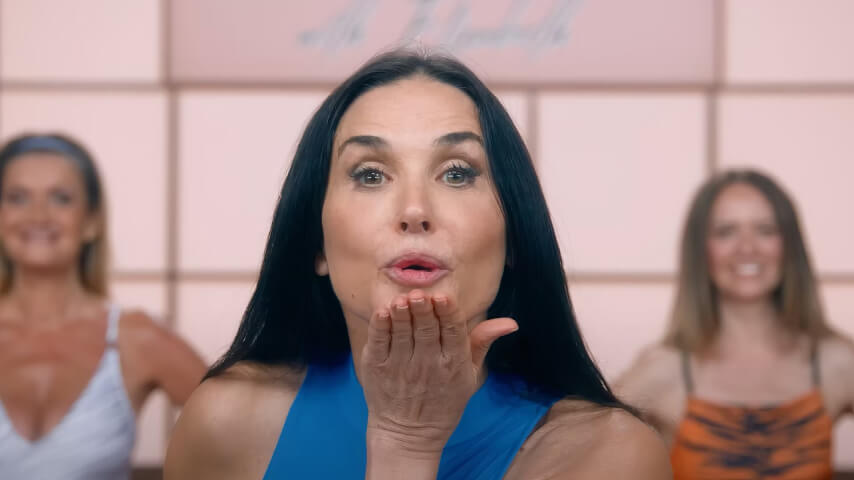Spoiler Space: When you wish upon a Substance
Coralie Fargeat's nasty film references body horror legends like David Cronenberg and the Disney princesses.

Spoiler Space offers thoughts on, and a place to discuss, the plot points we can’t disclose in our official review. Fair warning: This article features plot details of The Substance.
Mirror, mirror on the wall, who is the fairest of them all?
Most PopularIt’s a question posed again and again by The Substance, Coralie Fargeat’s orgiastic tale of blood, bile, and body dysmorphia. Lecherous men ask it openly as they hold auditions to replace their network’s aging star with one younger and more beautiful. The film’s dual leads, dialed to 11 by Demi Moore and Margaret Qualley, ask it of themselves as the poke and prod at the flesh reflected back at them—both through the looking glass and on the bones of their younger/older foil. Through all of this, the camera asks similar questions of its audience. How far would you go to turn back time and become a better version of yourself? Is that the wish you’d ask of your fairy godmother?
The fairy tale resonance is deliberate. The Substance first premiered at Cannes four months ago, and much ink has already been spilled about the film’s references to Kubrick, Hitchcock, Cronenberg, Lynch, Oscar Wilde, and even Death Becomes Her. All of these fingerprints are present, but there’s another body of work Fargeat is also drawing on to craft her twisted fable: Disney princesses, the original movie stars for so many little girls.
Related ContentIn The Substance, fading actress Elisabeth Sparkle (Moore) injects herself with radiation-green goo that curdles her insides to birth a younger, healthier version of herself called Sue (Qualley) out of a vagina in what used to be her back. The scene is exactly as gnarly as it sounds. If a Disney exec ever pitched it, they’d probably be thrown in the holding cell they allegedly keep in the theme parks and forced to watch Golden Age princess films Clockwork Orange-style.
And yet, the DNA of the Disney OGs codes The Substance, just as Elisabeth’s pulses through Sue. Snow White shows up in The Substance‘s many mirror scenes. Elisabeth pricks herself with a poison needle and falls into a dreamless slumber, just like Sleeping Beauty. Sue inspects her naked body, especially her butt and thighs, with the same level of wonder one might expect from a newly-landlocked Ariel. Tinkerbell, who needed attention in order to live, would have also fit in nicely in this grotesque (or just unmasked) version of Los Angeles: after the lengths these women go for the adoration they think they are owed, death would be a mercy.
The Mouse House is also stamped all over the aesthetic of The Substance, if you can catch it between the claustrophobic orange hallway and 2001-esque package center. Whichever woman is awake and in control gets to don a sweater spun in the exact shade of gold worn by Belle from Beauty And The Beast, and at the beginning of the film, Elisabeth receives red roses to let her know her time at the network is up. In both human and monster form—nay, beast form—Sue wears a poofy blue Cinderella dress for her New Year’s Eve show, and must hurry back home to stabilize herself lest she turn into a pumpkin and lose all her organs through the chasm in her back. All of cinematographer Benjamin Kracun’s fisheye shots also make Elisabeth/Sue’s fancy penthouse feel a lot more like Rapunzel’s cramped tower than anything resembling a real home. Sue is both helpless daughter and covetous stepmother as she skims what’s left of Elisabeth’s beauty to make her nasty spinal fluid Botox. Elisabeth is both Cinderella and jealous step-sister as she claws and tears at her own face before she can ever meet her prince. Both are trapped in a cold palace with a volatile beast. Neither can ever let down their hair.
The Substance invites viewers to take a glitter-free look at what happens when “happily ever after” doesn’t actually last that long. The princesses have exactly what Elisabeth and Sue crave most deeply: eternal youth, eternal beauty, eternal relevance. Rapunzel’s hair will never go gray. Sleeping Beauty’s eyes won’t sag. Cinderella will always be able to dance in her slippers. But what would they do if they were forced to grow up and become the women their creators drew as monsters? Wouldn’t they prick their finger on a spindle just to stop the clock?
Everyone wants to believe they’d say no to that creepy physician’s assistant and his DNA-altering concoction just like everyone wants to believe that they’re Snow White and not the Evil Queen. But by definition, the queen was once a princess herself. Instead of celebrating a woman for sitting on the throne, Disney has conditioned us to see female power as a reflection of all that’s been lost, and an inherently envious force that reflects that loss on others. Disney’s kings, like Triton and Mufasa, gaze out at everything the light touches; Disney’s queens sit in darkness, looking only at themselves. Even as a beast, the handsome prince finds love and comes back more beautiful than before, while the same cursed forces compress Elisabeth and Sue into a horrid monster no kiss could ever revive. Each woman fights tooth and nail for her fairy tale ending, but neither realize what side of the tale she’s on. For the princess to ride off into the sunset, the villain always has to die.
More from A.V. ClubGET A.V.CLUB RIGHT IN YOUR INBOX
Pop culture obsessives writing for the pop culture obsessed.
